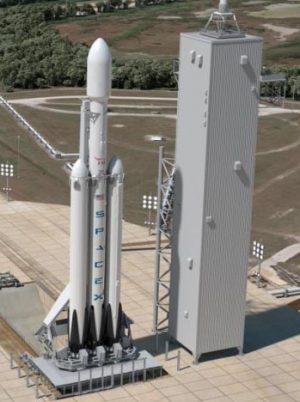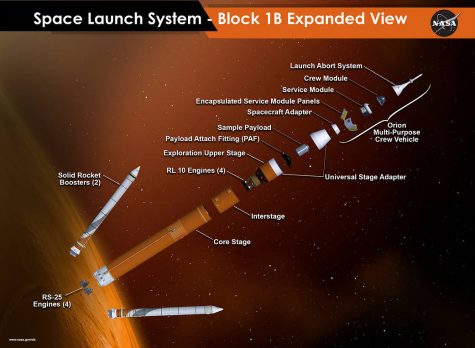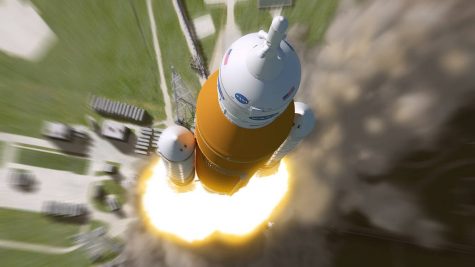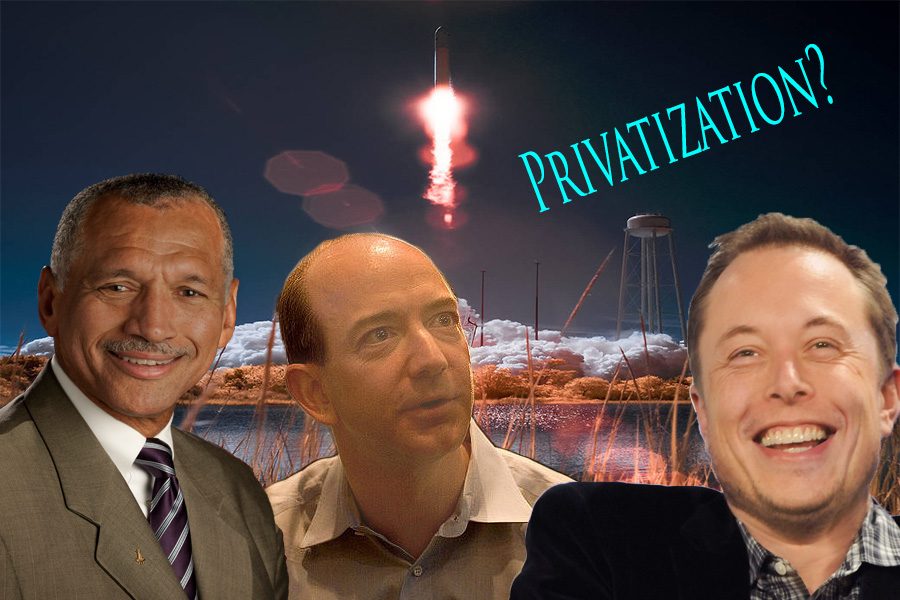Why the Space Industry Needs to be (Partially) Privatized
February 3, 2017
Following the second world war, the Unites States and the Union of Socialist Republics were at odds, butting heads on nearly every front they could find. Luckily, both countries were bestowed with some of the greatest engineers and rocket scientists the world had seen, which only provided a new rivalry. This time however, the missiles would not be pointed at one another. Instead, the goliaths poured resources into their space programs in a race to the moon, as called on by President Kennedy. The competition led to mass budget growth, intense national pride, and rapid development of technologies necessary for space travel such as solar panels, fire-proof suits, pacemakers, cordless drills, and handheld vacuums, just to name a few. Such rapid technological development in such a short amount of time is unparalleled. However, such innovation could be reinvigorated through a second space race, which is quietly developing among contractors today. If the space industry is further privatized, that unparalleled development could be replicated, this time with a Mars program instead of a Lunar program. After the USSR beat the US to put a man in space, the country would not allow another loss to the Soviets. Nine months later, John Glenn became the first man to orbit, and seven years later, Neil Armstrong became the first man on the Moon.
Since then, little has transpired in low Earth orbit and beyond. We’ve dabbled in experiments in zero gravity and organized a space station or seven, but nothing as paradigm-shifting or ground-breaking as the events from a few short decades ago. New Horizons flew by Pluto and photographed the first images of the dwarf planet up close, the Juno mission continues to study the Jovian (Jupiter) atmosphere and magnetic field, and Voyager 1 has left the solar system, bringing humanity’s culture into the expanse. The European Union’s space program, the ESA, recently landed a probe on Comet 67 in the historic Rosetta Mission. Each of these missions profound and exciting in themselves, but not one of them has revitalized American interest in space. How could such a noble and existential quest for knowledge so quickly fade into obscurity among the public?
Government budgeting.
On September 12th, 1962, President John Fitzgerald Kennedy challenged the country to put a man on the moon by the end of the decade. His challenge invigorated and inspired the American people. Following his assassination, that desire to reach the Moon remained. From then on, NASA’s budget increased dramatically every year. In 1963, the year Kennedy was assassinated, the budget for NASA rose from 9 billion dollars to 19 billion dollars. Then, by 1966, the budget had risen to 43 billion dollars, or a whopping four and a half percent of the government’s budget, taking the slot as the highest it has ever been to date. Later that decade, the United States of America sent two men to the Moon. After 1970, NASA’s budget slowly diminished. Since then, NASA is yet to launch a mission to match the fervor caused by the moon landings. Public interest had grown so low that, outside of hard-core space fans, no one really cared about NASA. Because of this, the space industry lost its importance in elections. Slowly, the space industry became less of a household topic and more so for space aficionados.

Enter Elon Musk, a South African-born immigrant with big ambitions and a will to improve humanity for the better. You may have heard of him, as he’s founded numerous companies such as Solar City, Tesla, PayPal, and most notably, SpaceX. His company aims to manufacture rockets that can be reused and refueled, to save money. His company is famous for landing their boosters on a barge, and now aims to put a man on Mars- before NASA can. On Tuesday, September 27th, Elon Musk held a press conference and announcement event of SpaceX’s plan to get to Mars, sending news outlets and enthusiasts everywhere into a frenzy. Reddit, Twitter, and other social media platforms went absolutely bananas over Musks’s announcement. His method to reach Mars utilizes a massive, interplanetary ship capable of carrying 100-200 people to and from Mars in a span of about 6 months. SpaceX also has a more conventional, Mars-capable rocket, the Falcon Heavy, which is scheduled to fly its first test launch in the second quarter of 2017. Like the Falcon 9, the Falcon Heavy’s first booster stages will return to a designated landing area to be reused for future launches. SpaceX is also planning privately funded cargo missions to Mars, using the human-rated Dragon 2 capsule launched via the Falcon 9.
In 2006, the United Launch Alliance was formed, a private partnership in space innovations between Lockheed Martin Space Systems and Boeing Defense, Space & Security. ULA constructs conventional rockets which have mostly been used to deliver government payloads into low Earth orbit, such as satellites for the Department of Defense and other agencies, while remaining independent from government control. This allows ULA to devote most of their profits to reinvesting and improving their launch vehicles, such as the Delta Heavy. The company will, however, be sending rovers and other missions to Mars under a contract with NASA. ULA will also be manufacturing the Space Launch System, or SLS for short.

The SLS is planned to be the workhorse of the space program, capable of going to the red planet and beyond. The main stage features four modified versions of engines used on the Space Shuttle, and two solid rocket boosters descended from the Shuttle’s SRBs, too. The SLS will be progressively upgraded as it ages, which will make it more capable of demanding missions, instead of designing and constructing a completely new rocket. NASA has already planned on plenty of missions utilizing the SLS, such as the Europa Mission, which plans to send a probe to the Jovian moon of Europa, the poorly named “Exploration Mission 2” which will bring a crew of four on a Lunar flyby, and the Asteroid Redirect Crewed Mission, bringing a different crew of four to an asteroid captured in the orbit of the Moon.
If that wasn’t enough, Jeff Bezos, founder of Amazon and the Washington Post, also has a hand in the Second Space Race. His company is called Blue Origin, and has a similar philosophy in payload to delivery as SpaceX, but on a much larger scale. In September 2016, Bezos announced Blue Origin’s newest design on Twitter, New Glenn. The rocket looks to be comparable in size to the Saturn V, the tallest rocket ever launched. Bezos, however, claims New Glenn will be one of the smaller orbital launchers in Blue Origin’s lineup. While little is known about the specifications or goals of New Glenn, it will most likely be a reusable rocket, like those of SpaceX, but on a scale more similar to the Falcon Heavy.
These companies have been paving the way in mass privatization. Should they continue, and if NASA’s budget stays constant, then privatization could be slated as the go-to way to put an object in orbit. Relatively soon, in the next 25 years or so, low earth orbit could be far more accessible, possibly even ferrying private personnel to orbit and back. This could also free up some of NASA’s funds, since costs for orbiting a human would be drastically reduced. As it stands, each seat on the Soyuz rocket costs about $80 million dollars, and SpaceX claimed at a news conference in 2012 that through their capsule Dragon, the cost per seat could be reduced to only $20 million.

Sawyer Rosenstein, member of the Talking Space podcast and consultant for the Intrepid Sea, Air, and Space Museum, said in an interview, “I think that the largest reason for lack of interest is that it became commonplace. In 1985, NASA launched 9 space shuttle missions in one year. That was, and still is, the record for most shuttle flights in one year. Now, people are doing new things never done before. Taking a first stage of a rocket, using it to launch a satellite, and landing it back on land was unheard of. Now add in landing it on a barge bobbing up and down in the middle of the ocean and it sounds even more sci-fi. The beauty of doing something new means having the ability to take science fiction and make it science fact,” he continued, “It takes some brilliant and crazy minds to do that, including people like Elon Musk. I love the idea of SpaceX reusing its boosters to fly again, but I fear that it will suffer the same fate as the space shuttle. The shuttle was sold as something that could launch, land, and then be refurbished and ready to fly again in weeks, flying dozens of times a year for cheap. NASA didn’t realize how much refurbishment was actually needed on the shuttle after it came back, and weeks turned to months to get an orbiter from landing to launch again. The one thing ULA offers besides “cheap” prices compared to SpaceX is reliability. ULA has launched 116 successful missions since its first launch back in 2006. In that time, they’ve only had 2 rockets that had a minor malfunction, but as of now 0 failures. All satellites they have launched have made it safely into orbit! The private companies are certainly here to stay in low earth orbit. Whether SpaceX can join the ranks of ULA is promising but yet to be seen. Until they can provide price, options and reliability like ULA, I worry that they might suffer the same fate as the space shuttle, which is promising more than you can deliver and end up costing yourself more money and safety in the long run.”
Jonathan Bailey, the sponsor for the BJHS Rocketry Club, said in an interview, “Innovation will ultimately be necessary for the future of the space industry, but the tried and true methods will most likely be build upon rather than thrown out. For example: the space shuttle program was incredibly innovative. Without the experiments it performed, the ISS would’ve been impossible. Now, however, we are returning to a more conventional method to build upon as we look to deep space.”
Payton Gloschat, a member of the Rocketry Club, said, “I believe the decline in interest was because it kind of became an old hat once things became standard. The first moon landing was fascinating and grabbed the attention of the world, but afterwards it felt like it was just watching the same thing, but with a different crew. I think interest is increasing now though, with companies like SpaceX making strides in the space industry and plans of taking man to another planet being openly discussed by both NASA, a public, government-run agency, and SpaceX, a private company outside of the public eye, alike.”
The privatization of the space industry is necessary if humanity wants to expand and more importantly, survive. Without proper competition, like that exemplified between ULA, SpaceX, and Blue Origin, there is little motivation to always be innovating and getting better. For example, what reason would there be to practice for any competitive sport if there was no one to play against? The drive to improve and better yourself would not be nearly as strong if the team is only competing against itself. The same applies to spaceflight. If ULA was the only company that could do launches for NASA, why would they strive to be more efficient? Thankfully, we have these companies to compete and spur innovation among one another. This is analogous to the great space race of the 60’s, pitting the USSR against the US in a race to the Moon. Hopefully, more companies can make their appearance on the grand stage of privatized rocket designing and launching, which would mean cheaper, faster, and safer safe travel for crew and cargo alike.












